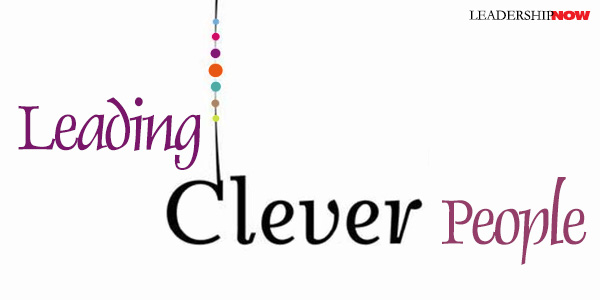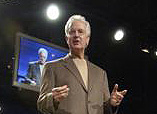 Leading Blog | Posts by Month |
 Leading Blog | Posts by Month |
09.30.09

LeadershipNow 140: September 2009 Compilation
Posted by Michael McKinney at 11:08 AM
09.22.09

Leading Views: PhD in Leadership, Short Course Dee Hock is the founder and former CEO of the VISA and author of One from Many: VISA and the Rise of Chaordic Organization. In Fast Company magazine he reduced leadership to its most basic relational (common sense) element. How often we forget this simple concept or are so unaware that we can’t get a fix on our own behavior. Dee Hock is the founder and former CEO of the VISA and author of One from Many: VISA and the Rise of Chaordic Organization. In Fast Company magazine he reduced leadership to its most basic relational (common sense) element. How often we forget this simple concept or are so unaware that we can’t get a fix on our own behavior.
"PhD in Leadership, Short Course: Make a careful list of all things done to you that you abhorred. Don't do them to others, ever. Make another list of things done for you that you loved. Do them for others, always."
Posted by Michael McKinney at 05:52 AM
09.16.09

The Application of Love LeadershipI wanted to share with you an excerpt from John Hope Bryant’s book Love Leadership. The subtitle – The New Way to Lead in a Fear-Based World – says it all. Bryant is the founder of Operation HOPE, a non-profit provider of economic tools and services that has as its long range objective to literally “drive itself out of business.”Bryant says we have “lost our story line;” too focused on the me instead of the we, we have become indifferent. He describes the opportunity to lead he found, this way: In inner cities today, you’ll often find a liquor store right next to a check casher, next to a pawn shop, next to a rent-to-own store, next to a payday lender. If misery loves company, then this is a pile-on. There’s simply a super-abundance of predatory businesses, and many people have lost hope. They are poor in spirit: they’re not skeptical—they’re cynical; they have low self-esteem and negative role models; their get-up-and-go has got up and went. So they go to the check-cashing service to forfeit their today, and go to the payday lender to forfeit their tomorrow. And because they don’t believe they’ll have a tomorrow, they go to the liquor store to forget about their yesterday.
Posted by Michael McKinney at 07:34 PM
09.14.09

Leading Clever People CLEVER people, according to Rob Goffee and Gareth Jones, are highly talented individuals with the potential to create disproportionate amounts of value from the resources that the organization makes available to them. Distinct from those individuals that thrive on their own, clevers need organizations to produce remarkable results. And organizations need them. They can be the competitive difference. In Clever the authors write, "Without clever people, leaders cannot hope to succeed. Without good leadership, clevers can never realize their full potential."
CLEVER people, according to Rob Goffee and Gareth Jones, are highly talented individuals with the potential to create disproportionate amounts of value from the resources that the organization makes available to them. Distinct from those individuals that thrive on their own, clevers need organizations to produce remarkable results. And organizations need them. They can be the competitive difference. In Clever the authors write, "Without clever people, leaders cannot hope to succeed. Without good leadership, clevers can never realize their full potential." Making the organization more valuable to the clevers requires a different approach from leaders. Leaders cannot be the ones that lead the charge up the mountain. "Rather they must identify the clever people with the potential to reach the summit, connect them with others, and help them get there. In fact, successful leaders of clevers they interviewed don't even think of themselves as leaders. Instead they refer to their roles as a compass ("to give that compass, that direction"), as a magnet ("you have to be a magnetic field. You never touch anything."), as a bridge (bridging the technical side and the management side), or as a plug ("connecting clever people to the rest of the business ... many clever people have a blind spot here born of their own conviction that their way is definitely the right way."). The paradox is that while they don't want to be led, they need leadership in order to achieve their potential and create value for society. Clever helps you to identify who the clevers are and in a very practical manner, what a clever organization should look like. Nestlé demonstrates the importance of clarity in the clever organization—"clear about your priorities and efficient in delivering objectives." While they are keenly aware of those aspects of the business they should never change they have been able to change and continually innovate. That means avoiding the tendency to process people, an over-reliance on systemization, an addiction to efficiency, and the division of labor and the alienation of the workforce. These tendencies are an anathema to clevers. The authors list several dos and don’ts for leading clevers:

Posted by Michael McKinney at 01:07 AM
09.10.09

Why Unemployed College Grads Should Channel Their Inner EntrepreneurDonna Fenn is the author of Upstarts! How GenY Entrepreneurs Are Rocking the World of Business and 8 Ways You Can Profit from Their Success. She offers this perspective:Last spring, the Bureau of Labor Statistics reported that unemployment among 18 to 25-year-olds was a staggering 16.1%. That was grim news for college grads, plenty of whom headed straight to grad school, or promptly moved their belongings into the family basement. If you are among this army of unemployed or underemployed young people, it's time you considered another option: start your own business. In the middle of a recession? Absolutely. Lots of great companies were founded in lousy economies: Trader Joe's, Clif Bar, MTV and Wikipedia are among them. Typically there's an uptick in startup activity during recessions. Why? Resources are cheaper, there's an available talent pool, and big companies that are focused on keeping their heads above water often let quality and service go by the wayside. That all spells opportunity for smaller, innovative, and agile players. Besides, what have you got to lose? Probably not much right now. You're young and you probably don't have a mortgage and a family to support. And rumor has it that you don't mind sleeping on futons or eating lots of Ramen. So if you've got an idea percolating, here's how to get started:
Posted by Michael McKinney at 10:00 PM
09.09.09

7 Attributes of Alliance All-StarsSteve Steinhilber says that “if alliances are not viewed as an integral part of your strategy, then you’re working with both hands tied behind your back…. You’ll need to develop alliance all-stars—no other investment is as important. Skimp in this area, and you’ll fall flat on your face.”In Strategic Alliances, Steinhilber describes the life of the alliance leader as one of “limbo, with little official power and ambiguous roles. Their jobs can be lonely outposts in many cases. They must be the internal advocate, external promoter, chief relationship builder, and master of personal influence. Their job is to identify the strategic value proposition between the companies and, at the end of the day, to be able to cultivate sponsors on both sides.” The goal is to create a sense of dynamic tension. This requires a special kind of leader. He has identified seven attributes to look for in alliance all-stars:
Posted by Michael McKinney at 08:45 AM
09.08.09

Leading Views: Why We Need Leaders Public philosopher Tom Morris expresses something in True Success: A New Philosophy of Excellence Public philosopher Tom Morris expresses something in True Success: A New Philosophy of Excellence"We all need help. We need guidance for our journeys through life. Even the most successful of us need reminders and fresh, crisp articulations of the truths we may only vaguely grasp that have, in one way or another, led us to whatever we have managed to accomplish. We need to rethink. We need to refocus. How can we get where we still need to go? And how can we best convey to others what it takes to get there together?"
Posted by Michael McKinney at 07:32 AM
09.07.09

What Is Your Platform? He lists seven practical ways you can invest your life in the lives of others:
Dale Murphy (Major League Baseball All-Star and founder of I Won't Cheat Foundation) is a sports celebrity who seeks to leverage his achievements on the playing field into a positive influence on the lives of others, especially young people. People in the sports world who are conscious of their influence often speak of their “platform.” In the literal sense, a platform is an elevated stage from which a person can speak and be heard by the crowd below. A sports celebrity has a platform of fame, which he or she can use to influence fans, young people and society at large.
Posted by Michael McKinney at 09:50 AM
09.04.09

How to Have More Productive Performance AppraisalsPaul Falcone asks “Does the thought of conducting a performance appraisal for your employees make you cringe?” In Productive Performance Appraisals, Falcone and co-author Randi Sachs set out to make the process more comfortable for all involved. They say that performance appraisals are nothing more than an ongoing feedback system. It also “represents a system of ongoing engagement with your subordinates that creates for them an environment of job satisfaction and motivation” and it will also “help you build a culture that focuses on performance excellence."The most important result is not the rating and encouragement of the employee, but the actual process itself. “By working together to analyze and evaluate the employee’s performance as well as his place within the department and the organization as a whole, and by setting goals for the near- and long-term future, you and your employee can strengthen your relationship and become a team of two adults working toward a common, agreed upon goal.” Here are several tips:
Posted by Michael McKinney at 09:17 AM
09.02.09

Do You Have a Court Jester?
I WROTE on Twitter, “As a leader, if you are not encouraging candid feedback, you are just asking for trouble. Do you have a court jester?” It’s a valid question. French politician Bernard Tapie wrote: “If you haven’t got people around who’ll tell you when to take a running jump, you're not a proper boss.” Manfred Ket de Vries has long advocated the need for a so-called “organizational fool.” He writes, “Leaders in all organizations need someone like this who is willing to speak out and tell the leader how it is. That is precisely the role of the fool.” David Riveness has given us The Secret Life of the Corporate Jester that delves into the specific task of the Court Jester—the concept of jestership. Leaders most often don’t receive the unvarnished truth and most organizational cultures don’t encourage it. As a result, blind spots in their thinking keeps them “from recognizing critical information, powerful choices, and clear paths to follow.” The lack of truth also creates a cycle of arrogance that feeds on itself. The jester concept is a perspective we need to incorporate and encourage in those around us. The jester understands that “in organizations, flawed actions result from an incomplete awareness and understanding of organizational truth.” Riveness suggests that the jester philosophy can be adopted in three distinct but complementary ways:
Jestership, Riveness writes, “could involve speaking your mind more often, speaking up for those that choose not to, challenging the status quo and illuminating the blind spots you uncover in more public ways. Remember to use your jester skills to perform all of the above with subtlety, creativity, and grace because this role can be very tricky—even dangerous if entered into haphazardly.” Most people aren’t ready to have their blind spots uncovered, so begin with your own. The example you set, will in time, draw others to the jester philosophy. 
Posted by Michael McKinney at 05:52 PM
09.01.09

First Look: Leadership Books for September 2009Here's a look at some of the best leadership books to be released in September.




For bulk orders call 1-800-423-8273
Posted by Michael McKinney at 12:11 AM
|
BUILD YOUR KNOWLEDGE


How to Do Your Start-Up Right STRAIGHT TALK FOR START-UPS 
Grow Your Leadership Skills NEW AND UPCOMING LEADERSHIP BOOKS 
Leadership Minute BITE-SIZE CONCEPTS YOU CAN CHEW ON 
Classic Leadership Books BOOKS TO READ BEFORE YOU LEAD |
|